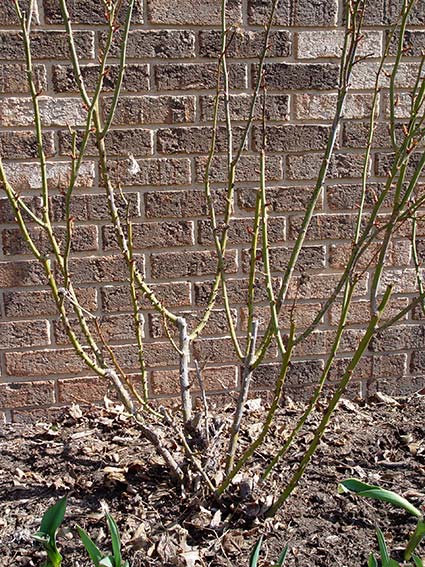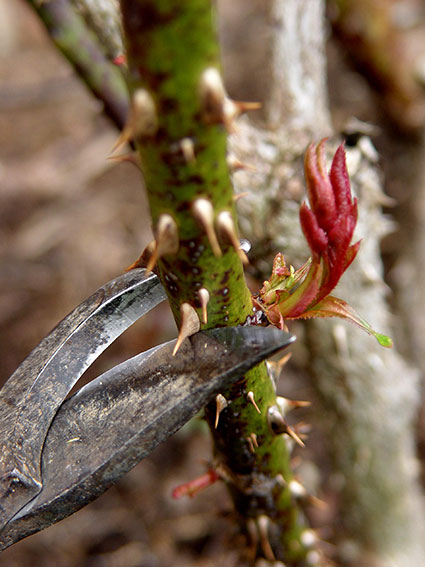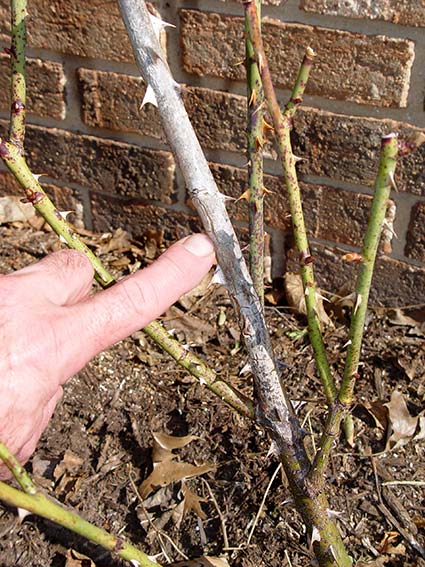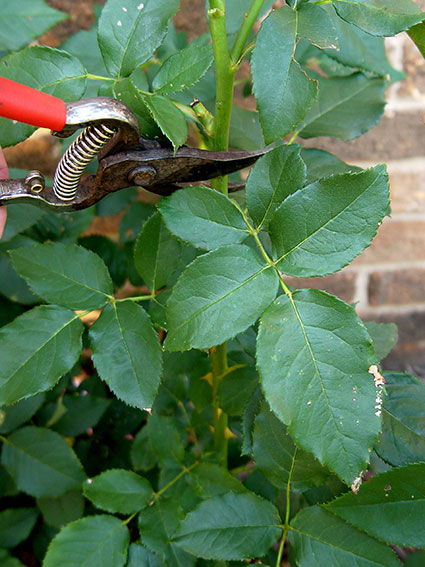Another Threat to Roses
Another new virus is killing roses throughout much of the United States. Learn how to spot the symptoms and project your roses against this deadly disease.
Rose bushes, with their exquisite flowers, might seem so delicate that the last thing you should do to them is give them a harsh whack-back. But brutal as it might seem, pruning is one of the best treatments you can give a rose bush. They’re tougher than you think. Even a botched job is unlikely to kill one.
Shrub roses, such as the top-selling Knock Out® line and old-fashioned Rosa rugosa (beach roses) types, are particularly easy to prune. Simply shear them back to about ankle-height just as new growth starts in spring; then shear them back again by one-third after the first flush of blooms fades.
Hybrid-teas, grandifloras, and floribunda types are the most common types grown in gardens. These bloom singly or in showy clusters at the tips of long canes and are often grown for cut flowers.

These before-and-after photos show how “ruthless” a spring rose-pruning should be. Thin bushes back to three to five canes, and then shorten those to as low as 6”- 8”. © George Weigel
Not even all rose experts agree on the best techniques and timing for pruning hybrid-teas, grandifloras, and floribundas, so don’t worry that there’s only one “right” way – lest you ruin your bushes. Just about everyone agrees that the heaviest pruning should happen toward the end of winter or in early spring, just as new shoots are emerging from the stems (canes). You will see new shoots sprouting on the old stems.
1. Remove any dead or damaged wood. You can tell the difference because live, healthy canes are green, while dead ones are gray, brown, or black. Another clue is that shoots don’t emerge from dead wood. Use sharp hand-pruners or loppers (a scissor-like tool with long handles), to cut all dead wood back to a main cane or even to the trunk, if necessary. Then look at the plant to select three to five “keeper” canes that are at least the thickness of a pencil. Ideally choose ones that are spaced evenly around the plant. Remove the biggest, oldest canes and the skinny ones – right back to where they attach to the base of the plant. Stop when you’re left with those three —five green canes between the size of a pencil and finger.
2. On roses that have been grafted (most of them—look for the graft scar bump at the base of the main stem), remove any shoots emerging from the ground instead of from the base of the bush. Shoots coming from the underground rootstock yield a different and usually inferior rose than the shoots coming from above the graft.
3. Shorten the three-five keeper canes to encourage stocky new growth for the upcoming season. Some growers cut them back to 12"-18", while others say it’s better to go lower – even down to 6"-8". Rose growers in warm-weather climates mostly take one-third off the ends of the canes. In any event, this ruthless treatment seems like a lot of wood to cut. Don’t be timid, though. Wimpy pruning leads to weak, floppy stems and the smaller flowers tend to droop instead of standing proudly.

Roses are best pruned to outward-facing buds or shoots. © George Weigel
Most experienced rose fans recommend selecting a spot on the stem just above an outward facing bud or shoot. As the side branches develop from outward facing buds they will grow outwards in a vase-like shape all around the plant. On the other hand cutting above an inward facing bud encourages growth inward toward the center of the plant, where they clog up the center and cross over one another, reducing healthy air flow.
How? The best way is to make a cut at a downward angle, about 1/8” above and behind the selected buds. To seal or not to seal the cut stems? Not everyone agrees on this, but although small cuts seldom need to be sealed, sometimes, large main stems benefit from a drop of liquid craft glue to prevent boring insects (especially sawfly larvae) from drilling into the canes and killing them.

Dead rose canes are gray in color instead of green. © George Weigel
During the season, some growers prune continuously throughout the growing season – constantly cutting stems back sharply as flowers bloom and then fade. Rather than just deadheading or snipping off the spent flowers, they cut the stem back to where the first five-leaf cluster occurs. (Roses may produce three-leaf lusters toward the tips.) Others cut only once or twice during the whole growing season, usually right after the first flush of blooms fades and/or in fall after frost has ended the growing season. At that time, the long “whippy” growth that might be snapped by winter winds must be tamed. It’s fine to shorten any overly long branches or to remove crossing branches any time during the growing season. Just curtail pruning by early fall, so as not to encourage soft new growth that is susceptible to frost damage.
Don’t prune any climbing rose until they’re at least 3 years old. The first two full seasons should be spent training main canes up the support. The goal with all climbers is to keep the main canes growing as upright as possible while shortening the side branches or “laterals.” Flowers grow off the laterals. Pruning depends on whether they’re once-and-done late-spring bloomers or repeat bloomers. The once-and-done bloomers are pruned right after that season’s flowers finish. Repeat bloomers get their heaviest pruning early, just before new growth begins in early spring, although they can be lightly snipped in late spring or summer, too.
Only remove main canes if they’re getting old, causing blooming to go downhill. Let new shoots replace the oldsters that you cut to the ground. With the laterals, shorten each of those back to four to eight buds or shoots. If the plant is getting too dense with a lot of shoots crossing over one another, go ahead and thin some out, back to the main cane.
Just a reminder: Invest in a quality pair of very thick, preferably leather, gauntlet gloves for pruning roses any time. Those thorns have a way of reaching out and biting hands that are in there trying to cut.

Keep roses compact in season by shortening branches back at least to the first cluster of five leaves. © George Weigel